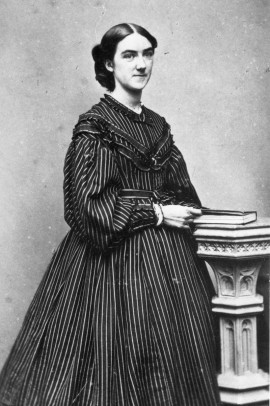Spotlight on early home economics

Ellen Swallow Richards was a 19th century pioneer in the field of home economics.
Photo: MIT Institute Archives and Special Collections
An interactive exhibition that demonstrates Jane Addams’ legacy for domestic life and public health will mark Jane Addams Day Dec. 10 at the Jane Addams Hull-House Museum.
“Unfinished Business: 21st Century Home Economics” will open with a reception from 4 to 6 p.m. at the museum. It will be on view through August 2013.
“If you care about urban farming, immigration reform, labor rights, or universal health and child care, you need to know this history, and you will be astounded by its continuing relevance today,” said Heather Radke, exhibition coordinator.
A museum ad campaign on Chicago Transit Authority buses says domestic labor is “the work that makes all work possible.”
Through public workshops, performances, conversations and hands-on activities, the exhibition describes the first-generation home economists of the early 20th century — equal rights advocates, chemists, public health advocates and labor reformers who sought to redefine domesticity.
Their goals were healthy food for all, fair labor practices for domestic work, ethical consumerism and community child-care solutions.
Exhibit organizers say the familiar images of early home economists canning, sewing and baking do not tell the story of the movement’s past or future.
“While much progress has been made on the issues Jane Addams and the reformers cared about, there is still much unfinished business. The work of creating a more just society continues,” Radke said.
The exhibition has four sections:
• Food and Hunger: historic menus detail the food programs Hull-House launched to transform the culture of food preparation and dining.
An audio piece by Radke and Chicago photographer Jason Rablando profiles Julia O’Grady, “lunch lady” at Chicago’s Academy for Global Citizenship, a public charter school. Multimedia profiles of other cafeteria workers will be created throughout the year by Street Level Youth Media.
• Domestic Labor: artifacts of caregiving, donated by the Chicago Coalition of Household Workers, are interpreted through labels written by domestic workers in a writing workshop led by teaching artist H. Melt of Young Chicago Authors.
On display will be the first national survey of domestic workers in the United States, “Home Economics: The Invisible and Unregulated World of Domestic Work.” The National Domestic Workers Alliance and UIC’s Center for Urban Economic Development surveyed about 2,300 nannies, housecleaners and caregivers in 14 cities to document their demographics, wages, working conditions and training needs.
An installation of woven, handcrafted rags by Collective Cleaners, a Chicago artists’ collective, explores cleaning as an artistic practice and invites visitors to think about place, history, privilege and labor.
• Child Care: a display of children’s blocks by contemporary child care activist groups from around the country tells a history of child care, with an interactive family activity developed by the Chicago Childcare Collective and illustrated by Corinne Mucha.
• Craft and Conscientious Consumption: artist Carole Frances Lung (Frau Fiber) devised an interactive installation that invites visitors to use early 20th-century sewing machines to “upcycle” used T-shirts, transforming them into tote bags.
